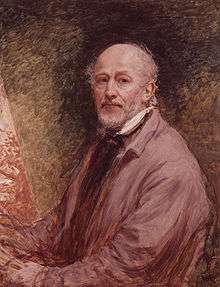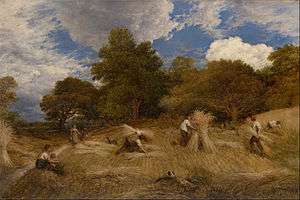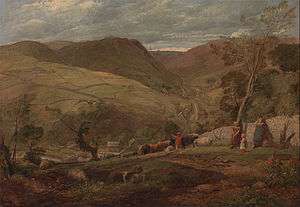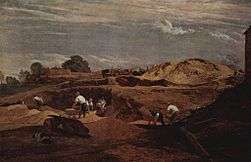John Linnell (painter)


John Linnell (16 June 1792 – 20 January 1882) was an English landscape and portrait painter and engraver. Linnell was a naturalist and a rival to John Constable. He had a taste for Northern European art of the Renaissance, particularly Albrecht Dürer. He also associated with William Blake, to whom he introduced Samuel Palmer and others of the Ancients.
Life and work
Linnell was born in Bloomsbury, London. His father was a carver and gilder and Linnell was brought into contact with artists from an early age, and was drawing and selling portraits in chalk and pencil at the age of 10. His first artistic instruction was received from Benjamin West, and he spent a year in the house of John Varley the water-colour painter, where he had William Hunt and William Mulready as fellow-pupils, and made the acquaintance of Shelley, Godwin and other men of mark. In 1805 he was admitted a student of the Royal Academy, where he obtained medals for drawing, modelling and sculpture. He was trained as an engraver, and executed a transcript of Varley's "Burial of Saul."[1]

In later life he occupied himself with the burin, publishing, in 1833, a series of outlines from Michelangelo's frescoes in the Sistine Chapel, and, in 1840, superintending the issue of a selection of plates from the pictures in Buckingham Palace, one of them, a Titian landscape, which he engraved in mezzotint. At first he supported himself mainly by miniature painting and execution of larger portraits, such as the likenesses of Mulready, Richard Whately, Peel and Thomas Carlyle. Several of his portraits he engraved in line and mezzotint.[1]
He painted many subjects like the "St John Preaching," the "Covenant of Abraham," and the "Journey to Emmaus," in which, while the landscape is usually prominent the figures are of sufficient importance to supply the title of the work. But it is mainly in connexion with paintings of pure landscapes that his name is known. His works commonly deal with some scene of typical uneventful English landscape, which is made impressive by a gorgeous effect of sunrise or sunset. They are full of true poetic feeling, and are rich and glowing in colour.[1]
Linnell commanded large prices for his pictures, and about 1850 he purchased a property at Redhill, Surrey, where he lived till his death on 20 January 1882, painting with unabated powers until within the last few years of his life. He devoted himself to painting landscapes notably of the North Downs and Kentish Weald.[2] His leisure was occupied with a study of the Bible in the original, and he published several pamphlets and treatises of Biblical criticism. Linnell was one of the best friends and kindest patrons of William Blake. He gave him the two largest commissions he received for single series of designs—£150 for drawings and engravings of The Inventions to the Book of Job, and a like sum for those illustrative of Dante Aligheri.[1]
He was a friend of the painter Edward Thomas Daniell. A blue plaque commemorates Linnell at Old Wyldes' at North End, Hampstead. The plaque mentions that William Blake stayed with Linnell as his guest.[3]
Gallery
.jpg) In Dovedale, 1814
In Dovedale, 1814
 Gravel pits of Kensington, 1811-1812
Gravel pits of Kensington, 1811-1812 The Prophet Balaam and the Angel - 1859
The Prophet Balaam and the Angel - 1859
Legacy
Linnell has over 150 oil paintings in public ownership in the United Kingdom.[4]
See also
Sources
- Alfred Thomas Story. The life of John Linnell: Volume 1, Volume 2 (London, R. Bentley and son, 1892).
References
| Wikimedia Commons has media related to John Linnell. |
- 1 2 3 4 Chisholm 1911.
- ↑ Wilton and Lyles, Andrew Wilton and Anne Lyles, Royal Academy of Arts (Great Britain), National Gallery of Art (U.S.) (1993). The great age of British watercolours, 1750-1880. New York: Prestel-Verlag. p. 339. ISBN 9783791312545. page 318
- ↑ "BLAKE, WILLIAM (1757-1827) & LINNELL, JOHN (1792-1882)". English Heritage. Retrieved 2012-08-05.
- ↑ Paintings by John Linnell at the Art UK site
- Attribution
 Chisholm, Hugh, ed. (1911). "Linnell, John". Encyclopædia Britannica (11th ed.). Cambridge University Press.
Chisholm, Hugh, ed. (1911). "Linnell, John". Encyclopædia Britannica (11th ed.). Cambridge University Press.
External links
- Linnell online (ArtCyclopedia)
- Linnell biography and Gallery (Fitzwilliam Museum)
- Linnell biography (History of Redhill & reigate))
 This article incorporates text from a publication now in the public domain: Lee, Sidney, ed. (1893). "Linnell, John". Dictionary of National Biography. 33. London: Smith, Elder & Co.
This article incorporates text from a publication now in the public domain: Lee, Sidney, ed. (1893). "Linnell, John". Dictionary of National Biography. 33. London: Smith, Elder & Co.  This article incorporates text from a publication now in the public domain: Chisholm, Hugh, ed. (1911). "article name needed". Encyclopædia Britannica (11th ed.). Cambridge University Press.
This article incorporates text from a publication now in the public domain: Chisholm, Hugh, ed. (1911). "article name needed". Encyclopædia Britannica (11th ed.). Cambridge University Press.